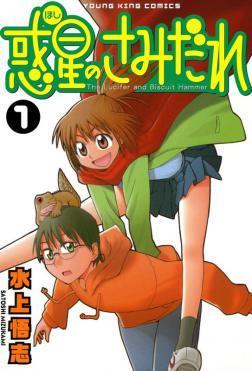Over the past couple months I’ve looked at both of Satoshi Mizukami’s works that are available in English, Spirit Circle and Hoshi no Samidare: The Lucifer and the Biscuit Hammer, and my feelings on Biscuit Hammer were rather lukewarm. I felt like Spirit Circle improved on all of the problems I had with the story but that was expected, it is a later work which means he had improved. I just wasn’t sure if it had been during Biscuit Hammer (especially given how prolific he is) and was barely interested in finding out. But I was curious, there was enough of a something in the story that I wanted to see how the world would be destroyed (or not, I didn’t think the Mizukami would actually end it that way) and, well, now that I’m done I’m really happy I did.
This is more editorial style than review style and covers all 10 volumes (5 omnibus volumes) so mild spoilers, none directing concerning the end of the series or any character’s eventual fate but they do explicitly lay out the set-up for the story.
For those who missed it, this is a story about saving the world. A man named Animus has been traveling back in time, after destroying that “present” with his giant biscuit hammer that dangles above the heavens, and his sister Anima each time has assembled twelve people to try and help her stop him. She and her beast knights haven’t been successful yet and so we come to the battle in our present day, Asamiya has just woken up to find a talking lizard on his bed and has no reason to save the world. He’s a closed off college student who was emotionally abused by his grandfather for years so it’s not the fantastical part of Neu’s explanation that he can’t believe, he just can’t see a reason why the world shouldn’t burn. His neighbor, high schooler Samidare, has taken a different approach to it. She has an incurable diease that’s seemingly in remission but the truth is that it’s because she’s been partnered with Anima for years and once she leaves it’ll come back, either way she’s going to die. Samidare loves the world however and wants to possess it and sees destroying it along with her as the best way to do so and takes a very active role in this wish (which is one translation for the Hoshi no Samidare part of the title). Asamiya is taken by her determination and smile and so they conspire in secret to defeat Animus the wizard and destroy the world themselves without ever telling the other 11 knights.
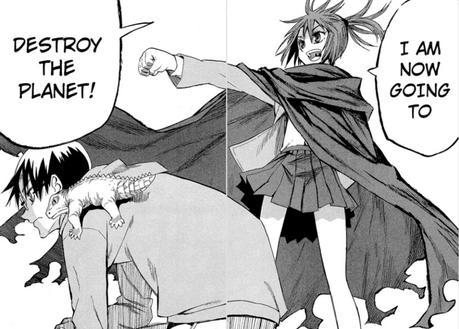
When I read the first two volumes the tone of the series felt completely off, it was determined to not be a serious story, which is fine, but it wasn’t going to be a parody or full out comedy either. It kept making “look look I made a joke that’s out of place for this kind of story AND I pointed it out, that makes it even funnier right!” jokes which felt forced and unfunny. These moments provided too great of a tonal contrast to the moments when the characters had surprisingly serious reasons for wanting to save or not save the world, plus the visual gags didn’t always work. But somewhere in the third volume it just started coming together for me and by the fourth volume it was working great. I’m not thrilled to say that you have to wait that long before the story gets good but at least with Seven Seas’ release that’s only the second (omnibus) volume. This is around the time that the rest of the beast knights are introduced and the story never abandons it’s attempts at humor but it lets itself settle into a slightly more serious vein, the tone feels rather similar to what Spirit Circle has been doing lately so I think that’s where Mizukami’s strength lies.
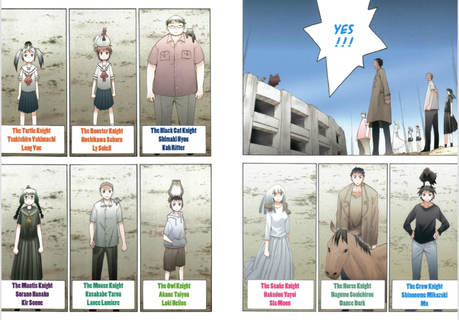
In the early part of the story there was a bit of a problem where Asamiya was most certainly the main character, not a likable one, and every chapter focused on him which made him grating. I’m sure that’s exactly what Mizukami intended to do but it doesn’t work as well as hoped. Once the story introduces the rest of the knights (two-thirds in one go, one of many ways that it successfully plays with standard storytelling tropes) the story is able to relax a little bit and bounce around the characters more, especially since enough time has passed that Asamiya is starting to become more friendly whether he realizes it or not. The story manages to flesh out all twelve knights surprisingly well and you never read the first few pages in a chapter and think “oh this is the rooster and turtle knights’ chapter”, you instead see Subaru (the Rooster Knight) and Yukimachi (the Turtle Knight) throughout the struggle trying to live up to their master, explaining their wishes to their beasts, and ultimately playing a huge role in coming up with the strategy for the final confrontation. Some characters, like Taiyou (the Owl Knight), are put through obvious, big struggles to get this character growth out of them but then we have Mikazuki (the Crow Knight) who seems to simply mellow out a little as the story goes on, perhaps from better dealing with his own problems (or at least having a better outlet for his incessant fighting) or Yayoi (the Snake Knight) whose determination is constantly demonstrated and we see both loud and quiet strengths.
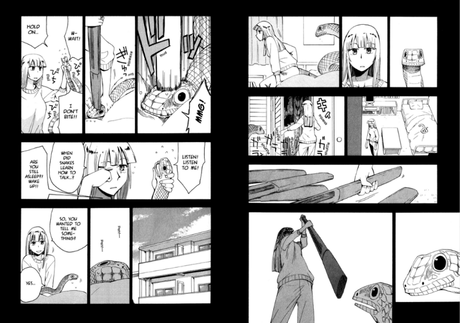
For a story where the word “superheroes” is occasionally bantered around, none of the characters here fit the traditional heroic archetypes (Souichirou the Horse Knight comes the closet with his background and somewhat single-minded devotion to stopping Animus, but still in a very human, imperfect way). No one is motivated by glory or a deep personal sense of justice, it’s a much smaller, more basic feeling of “well, I guess I have to do this and I think this is something worth doing” for many of the characters. The duos of Subaru and Yukimachi and Tarou (the Mouse Knight) and Hanako (the Mantis Knight) both exemplify this really well; Subaru and Yukimachi are some of the youngest of the cast they seem to view quest as just another, ordinary, part of life and work towards it together (with wanting to keep each other safe being their primary motivation for going along). Tarou is the closet we get to a typical shounen character but again, he’s motivated to save the world for the sake of the people he knows first and foremost and he has goals beyond this; in a lot of series pairing him with Hanako (a very quiet and reserved character without appearing to be one, the typical “I’m good at school but have no goals” person) would be to highlight how “wrong” Hanako’ worldview is but the series never chastises her, or similar Asamiya who starts out in the same vein, but seems content to wait and knows that people will always find motivation somewhere. That’s the heart of Hyou’s (the Black Cat Knight) struggle with creating his golems too and the story heavily suggests to it’s readers that the ultimate difference between Animus and everyone else is that he has forgotten that he is human and in a sense has lost his purpose/motivation that all of the other characters have spent so long working towards.
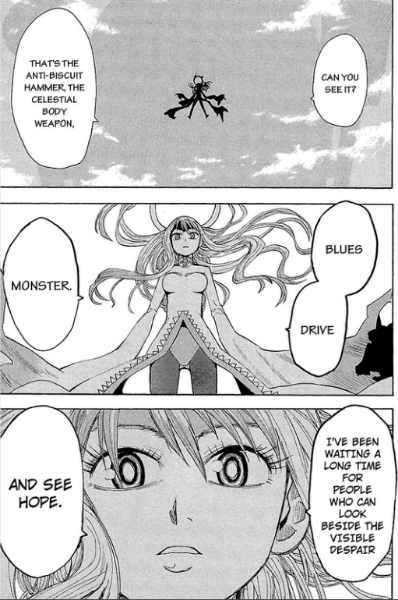
Given that the heart of the story is about the characters it doesn’t seem fair to say that the actual plot of this story is nothing special. Yes it’s a story about saving the world with a lot of fighting and a constant struggle to become stronger than the already strong golems, exactly what you would expect, but predictability is neither bad nor a hindrance here. The story excels at balancing the fantastical and the mundane as these characters fight for their own reasons and not out of duty, it gives even the simplest of victories a greater meaning. Nobody comes out without losing something but sometimes it was just losing their worldview and gaining another, a still-painful loss but one that might not have happened if a man hadn’t forgotten that he was not a god and forced others to find every reason to keep fighting and keep living.
